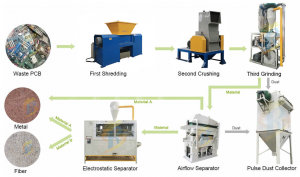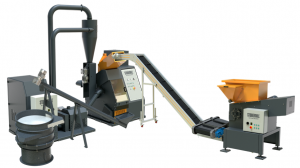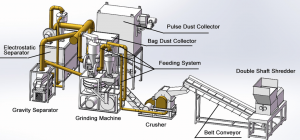Lesson 5 – Key Technologies for WEEE Recycling
Welcome to fifth lesson of our online course on WEEE recycling technologies. In this course, we will explore a variety of WEEE recovery technologies that allow the restoration of large quantities of metals for car manufacturing.
The most sought after resources are ferrous and non-ferrous metals such as aluminium, brass and copper, as well as the precious metals gold and silver.
Flow chart [https://www.sunymachine.com/NEWS/119.html]
Separation of materials using air or water flow with oscillating motions or magnets or currents to separate materials according to their specific properties. Material separation equipment depends on the type of waste or waste and the fractions we want to separate.
One of the most effective and widespread methods of recovery and separation of non-ferrous metals is separation by physical principle, i.e. by means of induced currents (or Eddy currents).
Magnetic separators – is a method used to separate ferrous and non-ferrous components from waste on a conveyor belt equipped with NdFeB magnets. The magnetic particles are attracted to the magnetic roller under the conveyor belt.
Induction separators (Eddy Current) – is a similar concept to magnetic separation, with a rotor aligned with neodymium magnets with alternating north and south poles, which produces an external magnetic field that repels non-magnetic metals. Materials with different conductivities produce different eddy currents and will therefore be thrown at different distances.
Electrostatic separators – is an electrostatic separation technology defined as “selective sorting of charged or polarized bodies in an electric field”, presents an efficient way to recycle metals and non-metals from WEEE without or with minimal negative impact on the environment.
Selective electrodynamic fragmentation – is a process of separation of composite structures that include metals. This process is used to recover decommissioned PCB waste.
ASR-Auto Shredder Residue technology – handles all the light fractions left over from the recycling of end-of-life vehicles (ELV’s). This obtained material represents up to 25% of ELV’s weight and contains different materials: plastic, rubber, glass, sand, textiles, wood, metals and dust.
Cu recovery technology – Copper is a 100% recyclable metal being the third most recycled metal after iron and aluminum. About 80% of all copper mined is still in use today and about 33% of the Cu used today is supplied from recycled materials, so recycling remains a key element in meeting the copper requirement in the industrial market.
Generally, about 65% of the copper produced is used for electrical applications (power generation, transformers, motors, cables, electrical circuits, wiring and contacts for electronic devices). 25% of all copper produced is used in buildings (for plumbing, roofing and cladding. Transport accounts for 7% of copper use (trains, trams, cars), of which a major part is used for electronic purposes. The remaining 3% is used for coins, sculptures, musical instruments and cookware.
Cable recycling facility – from STOKKERMILL TURBOFLEX LINE
Technologies for separating PCB components – where the presence of toxic metals and precious metals makes the recycling of this product necessary in order to combat environmental degradation, but also to capitalize on economic opportunities. The high cost of printed circuit boards (PCBs) in the automotive industry shows the need for end-of-life recycling.
PCB shredding machine E [from SUNY GROUP]
Metallurgical processing is the most widely used method for the recovery of secondary copper and a large part of electronic waste through copper smelting, a process that involves the reduction and melting of the material, the production of blister or raw copper in the converter, fire finishing, electrolytic refining and anodic mol processing . However, the method used for copper extraction depends on the nature of the ore.
Hydrometallurgical processing is carried out in liquid form, for the recovery of metals from ores, concentrates and salt solutions. The extraction of zinc, nickel and lead is done by solubilization in a multi-step process. Hydrometallurgy through the direct solubilization process achieves gold recovery through the PCB recycling process.
Electrometallurgical treatment is used to reduce metal ores or refine metals and is based on electrolysis, which involves the electrolysis of a molten salt or an aqueous solution. Electrolytic methods are important for obtaining more active metals such as sodium, magnesium and aluminum.


